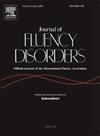Risk of stuttering onset and persistence linked to early language skills: Results from the Generation R Study
IF 2.1
3区 医学
Q1 AUDIOLOGY & SPEECH-LANGUAGE PATHOLOGY
引用次数: 0
Abstract
Background
Although linguistic factors are considered relevant to stuttering onset and its developmental course, the exact relationship between language and childhood stuttering remains unclear. Low, average and above-average expressive and receptive language skills have been associated with childhood stuttering. This study aimed to evaluate whether early language skills in children are associated with the risk of stuttering onset and persistence, using population-level data.
Methods
In a prospective, population-based cohort, we analyzed early-childhood language data from 123 nine-year-old with a history of stuttering (22 persistent, 101 recovered) and 2819 children without such a history. Expressive and receptive language skills were assessed at five time points using parental-reported questionnaires between 18 and 48 months of age. Multiple logistic regression analyses were performed.
Results
Higher expressive and receptive language skills at 24 months were significantly associated with a decreased risk of stuttering (Odds Ratio (OR), 0.78, 95 % Confidence Interval (CI) [0.65, 0.93], p-value < 0.01). Language assessments at 18, 30, 36 and 48 months showed no evidence of any association with stuttering (persistence).
Conclusion
These findings support previous studies indicating that lower language skills in early childhood add to the risk of stuttering onset, but not with the persistence of stuttering. This association does not imply causality, it only demonstrates the association. Therefore, clinicians are advised to screen language skills in pre-school children referred shortly after stuttering onset. Early language assessment may also reveal concomitant, clinically relevant language disorders, which are more prevalent in children already identified with one developmental concern.
R世代研究的结果:早期语言技能与口吃的发生和持续风险有关
虽然语言因素被认为与口吃的发生及其发展过程有关,但语言与儿童口吃之间的确切关系尚不清楚。低、平均和高于平均水平的表达和接受语言能力与儿童口吃有关。本研究旨在评估儿童早期语言技能是否与口吃发生和持续的风险有关,使用人口水平的数据。方法在一项前瞻性、基于人群的队列研究中,我们分析了123名有口吃史的9岁儿童(22名持续存在,101名恢复)和2819名无口吃史的儿童的早期儿童语言数据。在18到48个月大的时候,使用父母报告的问卷,在五个时间点评估表达和接受语言技能。进行多元逻辑回归分析。结果24个月时较高的语言表达和接受能力与口吃风险降低显著相关(优势比(OR), 0.78, 95 %置信区间(CI) [0.65, 0.93], p值<; 0.01)。在18个月、30个月、36个月和48个月的语言评估中,没有证据表明与口吃(持续性)有任何关联。结论这些发现支持了先前的研究,即儿童早期较低的语言技能会增加口吃发生的风险,但与口吃的持久性无关。这种联系并不意味着因果关系,它只是证明了这种联系。因此,建议临床医生在口吃发作后不久对学龄前儿童的语言技能进行筛查。早期语言评估也可能揭示伴随的、临床相关的语言障碍,这在已经确定有一种发育问题的儿童中更为普遍。
本文章由计算机程序翻译,如有差异,请以英文原文为准。
求助全文
约1分钟内获得全文
求助全文
来源期刊

Journal of Fluency Disorders
AUDIOLOGY & SPEECH-LANGUAGE PATHOLOGY-REHABILITATION
CiteScore
3.70
自引率
14.30%
发文量
23
审稿时长
>12 weeks
期刊介绍:
Journal of Fluency Disorders provides comprehensive coverage of clinical, experimental, and theoretical aspects of stuttering, including the latest remediation techniques. As the official journal of the International Fluency Association, the journal features full-length research and clinical reports; methodological, theoretical and philosophical articles; reviews; short communications and much more – all readily accessible and tailored to the needs of the professional.
 求助内容:
求助内容: 应助结果提醒方式:
应助结果提醒方式:


